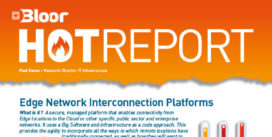Data Centres
Last Updated:
Analyst Coverage: Paul Bevan and David Terrar
They are the dedicated spaces used to locate and run servers, storage and networking equipment. In the heyday of the mainframe, data centres were specialist facilities, sometimes a completely separate building, sometimes specially constructed rooms within existing office locations, that provided the power, cooling, cabling and security to support large processing and storage cabinets.
As mainframe technology developed, delivering smaller and smaller footprints and mini computers and PCs took over more and more of the compute workload in a distributed environment, large data centres were demolished and smaller server rooms, requiring less specialised environments, sprang up.
The advent of the internet and cloud computing, based on a foundation of scale out architectures, has seen the resurgence of specialised data centre facilities and a new breed of data centre operators. Fuelled by the growth of hyper-scale cloud providers like AWS, Google and Microsoft Azure and the need for low latency, highly available networks to interconnect businesses with their customers and partners there has been an explosive growth in the construction of new data centre capacity.
Data Centres come in all shapes and sizes. The common denominator is that they all come with integrated security, environmental controls and operational management tools. They range in size from small “data centres-in-a-box” that can be wheeled into an office environment and wired in, through modular, prefabricated containers that can be dropped onto a site, to massive data centre campuses that have their own electrical generation capabilities.
Data Centres have been characterised as the manufacturing plants of the new industrial revolution. They are critical pieces of the infrastructure for both business and wider society, so much so that key internet exchange data centres in London Docklands are high on the list of facilities reviewed by the UK Government’s COBRA emergency response committee.
Data Centres are still places to locate your servers, storage and network equipment securely, safely and cost effectively. However, increasingly they have become network hubs where global, physical networks meet and where internet service providers place points of presence to serve widely dispersed customers. Nowadays they provide fast, secure connections to the major public clouds without the need for businesses to transfer across the sometimes slow and unreliable public internet, making hybrid cloud deployments a realistic proposition.
Designing and building a large data centre is a 15-year investment decision. For the https://www.bloorresearch.com/trends/, where rapid change is the norm and business agility a fundamental requirement, location and buy or build decisions about data centres are strategically important.
CEOs and CFOs should challenge any CIO who wants to build and manage his or her own data centre. They need to make a very strong case for building and running a new data centre, as opposed to making a very strong case to outsource.
CIOs and IT Architects need to ensure that data centres meet the needs of the business for availability of services, fast response times, seasonality, unpredictable demand and global coverage. Further, they need to be able to add or remove locations and capacity at short notice. This will require a sophisticated approach to commissioning and contracting for data centre services.
Data centres will be transacting most, if not all, the mission critical functions of the business. They will also be storing valuable and sensitive company and customer information. CISOs, Heads of Security and Audit Leads will need to assure themselves of the physical and information security capabilities of the data centre, as well as ensuring that regulatory controls such as GDPR are being adhered to.
There are a number of trends that are changing the nature of the data centre business, and others that impact the way in which data centres are designed and operated.
The growth of video on demand, on-line real-time financial trading, massive multi-player on-line gaming (MMOG) and other latency sensitive applications has been driving the growth of new data centres across the globe and an increase in the use of eco-systems of suppliers and partners directly connecting to each other inside data centres. Technologies such as photonics, network acceleration and network shaping have all had a hand in enabling and driving these changes.
There is a growing trend for Edge data centres. In relation to the growth in the latency sensitive applications mentioned above, certain data centre operators like EdgeConnex, opened data centres in second tier metropolitan areas to act as network concentrators, interconnect points and caching points for content distribution networks. The projected growth of connected devices, the Internet of Things (IOT), is driving a further need for data centres at the Edge, particularly for local storage and processing. This has led to multiple meanings for the term Edge computing and Edge data centres. This in turn has led many small regional data centres to call themselves, Edge data centres.
Hyper-scale data centre operators like Google and Facebook, where data centres form a large percentage of their cost base, have been instrumental in bringing new efficiencies to data centre designs and operations. Facebook has been strongly involved in the Open Compute Project (OCP) which is delivering new server designs and new rack configurations. There have been significant advances in airflow design, cooling technologies, data centre infrastructure management (DCIM), reuse of waste heat and the use of green energy sources. These developments have trickled down to other data centre operators which in turn have affected where and how data centres can be sited. This has also enabled them to configure for specific compute requirements, such as High-Performance Computing, they might have found difficult to accommodate previously.
While the hyper-scale players, AWS, Microsoft Azure, Google, Facebook and now Aliyun make the headlines and drive a significant amount of technological and business model change, there are a range of options for businesses looking to acquire data centre space and allied managed or outsourced services.
The traditional co-location market, where a business rents space, power and cooling for its own IT equipment has undergone some significant changes in recent years. Boundaries between retail and wholesale co-location have blurred, while there has been an increased emphasis on interconnectivity and global networks. Equinix and Digital Realty have grown organically and through acquisition, to become the major players in this market. While Telcos like NTT and KDDI have maintained their network of data centres and co-location services, others, such as Verizon have exited the market.
Amongst smaller co-location vendors we have seen some consolidation to provide scale, but more often than not there has been a focus on specific niches around HPC (Aegis Data), Bitcoin mining (Verne Global), security (The Bunker) or Green computing (Hydro66). Others (Node4), have chosen to provide additional services, often through acquisition, so that they effectively become more like hosting and managed services organisations.
Hosting services companies themselves, like Rackspace grew rapidly in the early 2000s, but hit with competition from AWS and Azure have moved to provide a wider range of cloud migration and consulting services.
Challenges posed by data sovereignty issues and concerns over market domination have seen the development of local cloud players and data centre operators like OVH and Etix Everywhere, both in France, being replicated elsewhere in Europe and across Asia.
Commentary
Solutions
These organisations are also known to offer solutions:
- 4D Data Centres
- Aegis Data
- AQL
- Aruba
- AWS
- Digital Realty
- EBRC
- EdgeConnex
- Equinix
- Etix Everywhere
- Hydro66
- IBM Softlayer
- Interxion
- Iomart
- Lefdal Mine
- Logicalis
- Lux Connect
- Microsoft
- NGD
- Node4
- NTT
- OVH
- Rackspace
- Telehouse
- The Bunker
- UKCloud
- Verne Global
- Virtus Data Centres
- Volta Data Centre
- Zenium




